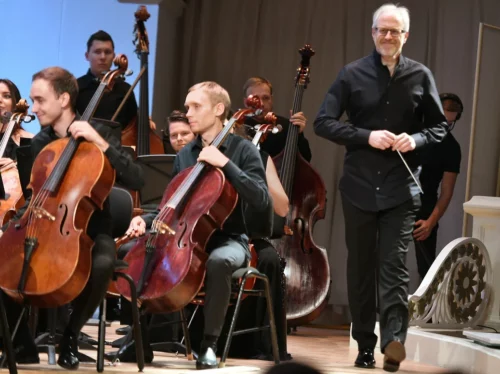Tchaikovsky Grant
Eight world premieres of Russian Music 2.1 at the Moscow Philharmonic
The Tchaikovsky Concert Hall hosted a concert of the laureates of the Russian Music 2.1 program, a joint project of the Aksenov Family Foundation, the Moscow Philharmonic, and the Moscow Museum of Modern Art. Composers present eight newest works performed by the Russian National Youth Symphony Orchestra (RNMSO) and the Moscow Contemporary Music Ensemble (MASM) conducted by Fyodor Lednev. Ilya Ovchinnikov attended the concert.

Eight world premieres in one evening – when was the last time this happened on the main stage of the Moscow Philharmonic and any other? Preparing to celebrate the centenary, one of the oldest concert organizations in the country not only recalls the glorious past: among other things, several new series of concerts dedicated to contemporary music has appeared, and this evening is certainly one of the most important. Moreover, it continued an initiative to support contemporary Russian composers (regardless of their place of residence). Aksenov Family Foundation launched the program in 2020 at its initiative, which provided grant support to eight authors selected by an expert council.
Combining the efforts of the Philharmonic and the Foundation is a natural and timely step: the concert of last season’s laureates was at the Meyerhold Center, but it turned out that the Tchaikovsky Hall with a program of some world premieres written by authors who are in their prime today. According to the usual logic of concerts involving an ensemble and an orchestra, the orchestra performs last; This time, it was different and for the better. Unfortunately, the intermission dragged on, and the performance “Spokoyno” by Alexander Chernyshkov, which followed, turned out to be longer than the other three numbers of the second part taken together and did not allow the audience to hear them properly. Especially for those who did not wait for them. Despite the dedication of the MASM soloists. And if there were many exciting things in the works of Anton Vasiliev and Elena Rykova, then Marina Poleukhina’s opus, also in the performance genre, seemed outdated even before it was written and ended the evening not very successfully.
On the other hand, the first part was perceived as a single percussive chord from the point of view of both organization, alignment, and the music itself. All four pieces answered “yes” to whether composers between the ages of 30 and 50 can write not only “for two oboes, a harmonica, and a vacuum cleaner” or an ensemble of soloists but also for a large orchestra. It is impossible not to call the heroes of the RNMSO artists, who, under Fyodor Lednev, prepared and brilliantly performed the four newest, most complex, and completely different scores. The program elements succeeded each other with the clarity of an ideal mechanism: the composer’s video presentation – a ten-minute play – a short commentary by the presenter Yaroslav Timofeev – and so on. The words of the composers were no less interesting than the music.
“My play is not easy, just crazy” – Alexandra Filonenko about her “Memory Code”: an impressive chronicle of the work of the author’s memory, which did not sound at full strength due to a phonogram that did not turn on in time. “I am an anxious cat,” Oleg Krokhalev introduces himself, whose play “Catcher” begins and ends with long pauses. Its main plot is the interaction between the musicians and the sound engineer, who broadcasts the prepared sounds into the hall between two orchestras. “We don’t have anything of our own. There is nothing like nothing else” – the ideology of Vladimir Rannev. The hero of his “The Strongest” is Arina Zvereva, to whose singing the orchestra reacts as if in real-time: by the finale, almost all of them play triangles – 75 pieces – and I want to listen more, ten minutes is not enough.
Vladimir Gorlinsky is not limited to such frames – his “Terracotta” lasts almost half an hour. “Compared to religion and mystical experience, music is cooler,” the composer claims and proves this by presenting something like a giant instrumental theater. Singers with megaphones walk around the hall, wind and orchestra players on stage laugh out loud. It sounds like a march and much more – but words cannot express how and why it merges into a single and very musical whole with an utterly unexpected major in the finale.
